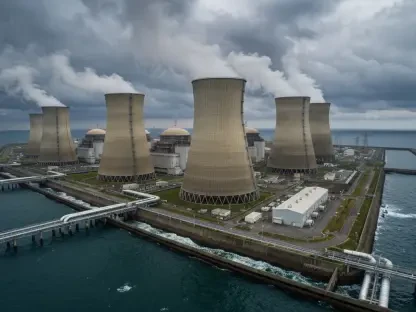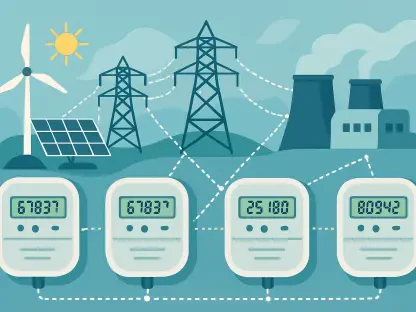In a world increasingly desperate for sustainable energy solutions, a surprising opportunity has emerged from the shadows of industrial decay, where abandoned coal mines—once symbols of environmental destruction—could become the unlikely heroes of a clean energy future. These scarred landscapes, often left barren and polluted after decades of coal extraction, are being reimagined as potential solar power hubs with the capacity to generate significant renewable energy. This innovative concept not only promises to address the pressing need for green power but also offers a chance to heal the wounds of past industrial activities by transforming degraded lands into productive assets. The scale of this potential is staggering, with estimates suggesting a capacity of up to 300 gigawatts (GW) of solar energy could be harnessed globally from such sites. This transformative idea is already taking root in certain regions, sparking curiosity about whether these relics of a bygone era can truly light the way toward a brighter, more sustainable tomorrow.
Unlocking Potential from Industrial Ruins
Repurposing Degraded Landscapes for Solar Power
The notion of converting abandoned coal mines into solar farms represents a striking shift in how society views industrial wastelands, turning them from burdens into valuable resources. Across the globe, thousands of square kilometers of land lie idle after coal operations have ceased, often within close proximity to existing electrical grids—sometimes less than 10 kilometers away. This strategic location makes them ideal for renewable energy projects, as connecting to national power systems becomes far less costly and complex. Data from energy monitoring organizations indicate that approximately 5,820 square kilometers of such degraded land are currently available for redevelopment. With a potential output of 300 GW, these sites could play a pivotal role in meeting global renewable energy targets. The transformation of these areas not only addresses energy needs but also symbolizes a poetic reversal, where the darkest remnants of industrial history become beacons of clean power generation, offering hope for a sustainable future.
Environmental Restoration Through Renewable Innovation
Beyond energy production, the repurposing of coal mine sites offers a profound opportunity for environmental restoration, tackling the legacy of pollution and land degradation left by decades of mining. These areas are often plagued by contaminated soil, unstable terrain, and disrupted ecosystems, rendering them unsuitable for most forms of redevelopment. By installing solar photovoltaic systems, projects can help stabilize the land, reduce dust pollution, and even facilitate revegetation efforts in surrounding areas. In regions like China, where over 90 solar projects on former coal mines already generate 14 GW of power, the dual benefit of clean energy and ecological recovery is evident. Such initiatives demonstrate that renewable energy development can go hand in hand with healing the planet, providing a model for other nations to follow. This approach underscores the possibility of turning environmental liabilities into assets, creating a synergy between sustainability goals and the urgent need to rehabilitate damaged landscapes.
Overcoming Barriers to a Solar Future
Navigating Technical and Logistical Challenges
While the vision of solar farms on abandoned coal mines is inspiring, significant technical and logistical hurdles must be addressed to make this a reality on a global scale. Unstable ground conditions, often a result of extensive underground mining, pose risks to the structural integrity of solar installations, requiring specialized engineering solutions. Additionally, contaminated soil and water management issues demand careful remediation before any construction can begin, adding layers of complexity and cost to projects. Dust control is another persistent challenge, as barren mine sites are prone to erosion, which can damage solar panels and reduce efficiency. These obstacles highlight the importance of thorough site assessments and innovative technologies to ensure the feasibility of such transformations. Without strategic planning and investment, the promise of harnessing vast renewable energy from these locations risks remaining an unfulfilled dream, stalling progress toward cleaner energy systems.
Addressing Policy and Community Concerns
Equally critical to the success of converting coal mines into solar hubs are the policy frameworks and community dynamics that shape these projects, as land rights and local opposition can derail even the most well-intentioned plans. Many former mining areas are entangled in complex ownership disputes, with multiple stakeholders claiming rights to the land, necessitating clear legal resolutions before development can proceed. Furthermore, communities near these sites, often economically dependent on coal in the past, may harbor skepticism about renewable energy initiatives, fearing insufficient job creation or cultural disruption. Policymakers must prioritize transparent dialogue and inclusive planning to address these concerns, ensuring that local populations benefit from new employment opportunities in solar farm construction and maintenance. By fostering trust and crafting supportive regulations, governments can pave the way for smoother transitions, balancing the economic revitalization of struggling regions with the broader goal of sustainable energy production.
A Legacy of Renewal
Reflecting on the journey from coal to solar, it becomes clear that what once stood as a testament to environmental harm has been reimagined as a cornerstone of green innovation. Abandoned coal mines, long seen as scars on the earth, are gradually being transformed into symbols of hope through pioneering solar projects that tackle both energy demands and ecological restoration. The challenges of unstable terrain and policy intricacies are being met with determination and ingenuity, proving that even the most daunting obstacles can be overcome with the right strategies. Looking ahead, the focus must shift to scaling these efforts globally, ensuring that technical solutions and community engagement remain at the forefront of planning. Governments and industry leaders should invest in research to refine solar technologies for degraded lands while fostering international collaboration to share best practices. This path forward promises not just a cleaner energy landscape but a redefined narrative of industrial spaces, turning past burdens into enduring contributions to a sustainable world.









